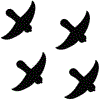The Certainty of Ambiguity in Visual Neural Representations
- PMID: 34524881
- PMCID: PMC8687672
- DOI: 10.1146/annurev-vision-100419-125929
The Certainty of Ambiguity in Visual Neural Representations
Abstract
Some images evoke bistable percepts: two different visual experiences seen in alternation while continuously viewing an unchanged stimulus. The Necker Cube and Rubin's Vase are classic examples, each of which gives alternating percepts of different shapes. Other bistable percepts are alternating colors or directions of motion. Although stimuli that result in salient bistability are rare and sometimes cleverly constructed to emphasize ambiguity, they have been influential for over 150 years, since the work of von Helmholtz, who considered them to be evidence for perceptual visual processes that interpret retinal stimuli. While bistability in natural viewing is uncommon, the main point of this review is that implicit ambiguity in visual neural representations is pervasive. Resolving ambiguity, therefore, is a fundamental and ubiquitous process of vision that routinely affects what we see, not an oddity arising from cleverly crafted images. This review focuses on the causes of widespread ambiguity, historical perspectives on it, and modern knowledge and theory about resolving it.
Keywords: ambiguity; bistable perception; contextual influences; unconscious inference; visual perception.
Figures







Similar articles
-
Perceptual ambiguity of bistable visual stimuli causes no or little increase in perceptual latency.J Vis. 2010 Apr 29;10(4):23.1-15. doi: 10.1167/10.4.23. J Vis. 2010. PMID: 20465341
-
Perceptual inference employs intrinsic alpha frequency to resolve perceptual ambiguity.PLoS Biol. 2019 Mar 13;17(3):e3000025. doi: 10.1371/journal.pbio.3000025. eCollection 2019 Mar. PLoS Biol. 2019. PMID: 30865621 Free PMC article.
-
Contribution of disparity to the perception of 3D shape as revealed by bistability of stereoscopic Necker cubes.Seeing Perceiving. 2012;25(6):561-76. doi: 10.1163/18784763-00002396. Seeing Perceiving. 2012. PMID: 23550365
-
Cueing the interpretation of a Necker Cube: a way to inspect fundamental cognitive processes.Cogn Process. 2009 Feb;10 Suppl 1:S95-9. doi: 10.1007/s10339-008-0244-9. Epub 2008 Dec 2. Cogn Process. 2009. PMID: 19048318
-
"Binaural rivalry": dichotic listening as a tool for the investigation of the neural correlate of consciousness.Brain Cogn. 2011 Jul;76(2):218-24. doi: 10.1016/j.bandc.2011.02.007. Epub 2011 Mar 21. Brain Cogn. 2011. PMID: 21421284 Review.
Cited by
-
Equivalent noise characterization of human lightness constancy.J Vis. 2022 Apr 6;22(5):2. doi: 10.1167/jov.22.5.2. J Vis. 2022. PMID: 35394508 Free PMC article.
-
Combined fMRI and eye-tracking evidence on the neural processing of visual ambiguity in photographic aesthetics.Sci Rep. 2025 Apr 15;15(1):12971. doi: 10.1038/s41598-025-97945-w. Sci Rep. 2025. PMID: 40234560 Free PMC article.
-
Binocularly-driven competing neural responses and the perceptual resolution of color.J Vis. 2021 Sep 1;21(10):15. doi: 10.1167/jov.21.10.15. J Vis. 2021. PMID: 34542576 Free PMC article.
-
Perceptual Resolution of Ambiguity: Can Tuned, Divisive Normalization Account for both Interocular Similarity Grouping and Difference Enhancement.bioRxiv [Preprint]. 2024 Jun 26:2024.04.01.587646. doi: 10.1101/2024.04.01.587646. bioRxiv. 2024. PMID: 38617235 Free PMC article. Preprint.
-
Context-Sensitive Conscious Interpretation and Layer-5 Pyramidal Neurons in Multistable Perception.Brain Behav. 2025 Mar;15(3):e70393. doi: 10.1002/brb3.70393. Brain Behav. 2025. PMID: 40038853 Free PMC article. Review.
References
-
- Adams WJ, Graf EW, Ernst MO. 2004. Experience can change the “light-from-above” prior. Nat. Neurosci 7(10):1057–58 - PubMed
-
- Adelson EH. 1993. Perceptual organization and the judgment of brightness. Science 262:2042–44 - PubMed
-
- Alais D, Burr D. 2004. The ventriloquist effect results from near-optimal bimodal integration. Curr. Biol 14(3):257–62 - PubMed
-
- Alais D, O’Shea RP, Mesana-Alais C, Wilson IG. 2000. On binocular alternation. Perception 29:1437–45 - PubMed
Publication types
MeSH terms
Grants and funding
LinkOut - more resources
Full Text Sources

